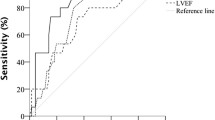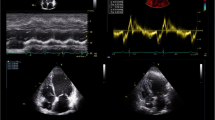Abstract
Purpose
The aim of this work was to compare the prevalence of right ventricle involvement in a population of patients with myocardial infarction as detected by cardiac magnetic resonance (CMR), clinical presentation, electrocardiographic (ECG) and echocardiographic criteria.
Materials and methods
A total of 97 consecutive patients, admitted to our institution for acute myocardial infarction, underwent a standard CMR examination within 5 days after the event. The presence of myocardial oedema and late enhancement of the right ventricle were compared to infarct location (anterior vs. inferior), clinical data, ECG, echocardiography results and other CMR findings. The results were analysed statistically using the Student’s t test for independent samples and the K statistic.
Results
Among the 97 patients included in the study, a diagnosis of right ventricular infarction was established in 12, 14 and 24 cases on the basis of the clinical data, the ECG and echocardiography, respectively. CMR demonstrated myocardial oedema and late enhancement of the right ventricle in 48 and 32 cases, respectively. The right ventricle was involved in 46 % of patients with inferior myocardial infarction (15/32) and in 30 % with anterior myocardial infarction (17/56), correlating to a worsening of both right and left ventricular performance (p = 0.001–0.05).
Conclusions
The right ventricle is frequently involved in myocardial infarction, correlating to a worse functional impairment of both ventricles and a worse prognosis. This finding, which is often underestimated by traditional cardiological tests, is well revealed by CMR, with potential clinical and therapeutic impact.



Similar content being viewed by others
References
Kinch JW, Ryan TJ (1994) Right ventricular infarction. N Engl J Med 330:1211–1217
Hamon M, Agostini D, Le Page O et al (2008) Prognostic impact of right ventricular involvement in patients with acute myocardial infarction: meta-analysis. Crit Care Med 36:2023–2033
Wong CK, Gao W, Stewart RA et al (2010) Prognostic value of lead V1 ST elevation during acute inferior myocardial infarction. Circulation 122:463–469
Goldstein JA (2002) Pathophysiology and management of right heart ischemia. J Am Coll Cardiol 40:841–853
Mehta SR, Eikelboom JW, Natarajan MK (2001) Impact of right ventricular involvement on mortality and morbidity in patients with inferior myocardial infarction. J Am Coll Cardiol 37:37–43
Zehender M, Kasper W, Kauder E et al (1993) Right ventricular infarction as an independent predictor of prognosis after acute inferior myocardial infarction. N Engl J Med 328:981–988
Foussas SG, Zairis MN, Tsiaousis GZ et al (2010) The impact of right ventricular involvement on the postdischarge long-term mortality in patients with acute inferior ST-segment elevation myocardial infarction. Angiology 61:179–183
Lopez-Sendón J, Coma-Canella I, Viñuelas Adanez J (1981) Volume loading in patients with ischemic right ventricular dysfunction. Eur Heart J 2:329–338
Zeymer U, Neuhaus KL, Wegscheider K et al (1998) Effects of thrombolytic therapy in acute inferior myocardial infarction with or without right ventricular involvement. HIT-4 trial group. Hirudin for improvement of thrombolysis. J Am Coll Cardiol 32:876–881
Ferrario M, Poli A, Previtali M et al (1994) Hemodynamics of volume loading compared with dobutamine in severe right ventricular infarction. Am J Cardiol 74:329–333
Herrmann J (2010) Leave me alone: the right ventricle in anterior myocardial infarction. Cardiovasc Res 87:585–586
Rambihar S, Dokainish H (2010) Right ventricular involvement in patients with coronary artery disease. Curr Opin Cardiol 25:456–463
Masci PG, Francone M, Desmet W et al (2010) Right ventricular ischemic injury in patients with acute ST-segment elevation myocardial infarction: characterization with cardiovascular magnetic resonance. Circulation 122:1405–1412
Cohn JN, Guiha NH, Broder MI, Limas CJ (1974) Right ventricular infarction. Clinical and hemodynamic features. Am J Cardiol 33:209–214
Burgess MI, Bright-Thomas RJ, Ray SG (2002) Echocardiographic evaluation of right ventricular function. Eur J Echocardiogr 3:252–262
Bondarenko O, Beek AM, Hofman MB et al (2005) Standardizing the definition of hyperenhancement in the quantitative assessment of infarct size and myocardial viability using delayed contrast-enhanced CMR. J Cardiovasc Magn Reson 7:481–485
Isner JM, Roberts WC (1978) Right ventricular infarction complicating left ventricular infarction secondary to coronary heart disease. Frequency, location, associated findings and significance from analysis of 236 necropsy patients with acute or healed myocardial infarction. Am J Cardiol 42:885–894
Francone M, Carbone I, Agati L et al (2011) Utility of T2-weighted short-tau inversion recovery (STIR) sequences in cardiac MRI: an overview of clinical applications in ischaemic and non-ischaemic heart disease. Radiol Med 116:32–46
Kumar A, Abdel-Aty H, Kriedemann I et al (2006) Contrast-enhanced cardiovascular magnetic resonance imaging of right ventricular infarction. J Am Coll Cardiol 48:1969–1976
Grothoff M, Elpert C, Hoffmann J et al (2012) Right ventricular injury in ST-elevation myocardial infarction: risk stratification by visualization of wall motion, edema, and delayed-enhancement cardiac magnetic resonance. Circ Cardiovasc Imaging 5:60–68
Jensen CJ, Jochims M, Hunold P et al (2010) Right ventricular involvement in acute left ventricular myocardial infarction: prognostic implications of MRI findings. AJR Am J Roentgenol 194:592–598
Desai MY, Gupta S, Bomma C et al (2005) The apparent inversion time for optimal delayed enhancement magnetic resonance imaging differs between the right and left ventricles. J Cardiovasc Magn Reson 7:475–479
Grosse-Wortmann L, Macgowan CK, Vidarsson L, Yoo SJ (2008) Late gadolinium enhancement of the right ventricular myocardium: is it really different from the left? J Cardiovasc Magn Reson 8:10–20
Kaandorp TA, Lamb HJ, Poldermans D et al (2007) Assessment of right ventricular infarction with contrast-enhanced magnetic resonance imaging. Coron Artery Dis 18:39–43
Ibrahim T, Schwaiger M, Schömig A (2006) Images in cardiovascular medicine. Assessment of isolated right ventricular myocardial infarction by magnetic resonance imaging. Circulation 113:e78–e79
Johnston WE, Vinten-Johansen J, Patel A, Santamore WP (1989) Right ventricular free wall ischemia: correlation of ischemic duration with extent of infarction in dogs. Ann Thorac Surg 47:729–734
Conflict of interest
Nicola Galea, Marco Francone, Iacopo Carbone, David Cannata, Francesco Vullo, Roberto Galea, Luciano Agati, Francesco Fedele, Carlo Catalano declare no conflict of interest.
Author information
Authors and Affiliations
Corresponding author
Rights and permissions
About this article
Cite this article
Galea, N., Francone, M., Carbone, I. et al. Utility of cardiac magnetic resonance (CMR) in the evaluation of right ventricular (RV) involvement in patients with myocardial infarction (MI). Radiol med 119, 309–317 (2014). https://doi.org/10.1007/s11547-013-0341-4
Received:
Accepted:
Published:
Issue Date:
DOI: https://doi.org/10.1007/s11547-013-0341-4




